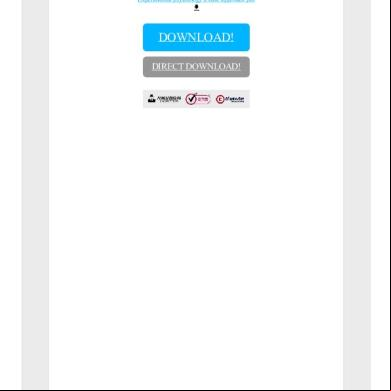Decreased Cardiac Output 734c1w
This document was ed by and they confirmed that they have the permission to share it. If you are author or own the copyright of this book, please report to us by using this report form. Report 2z6p3t
Overview 5o1f4z
& View Decreased Cardiac Output as PDF for free.
More details 6z3438
- Words: 430
- Pages: 3
Melbourne, Florida Individual Nursing Care Plan NURSING DIAGNOSIS STATEMENT Nursing Diagnosis Statement: Risk for decreased cardiac output r/t altered heart rate/rhythm.
GOALS
LONG TERM GOAL: Client will maintain adequate cardiac output AEB BP and pulse within normal range while in hospital 1. SHORT TERM GOAL:
Level of Maslow's Hierarchy: Physiological
INTERVENTIONS
Client will display absence of dysrhythmias
1-1. Palpate radial, carotid, femoral and dorsalis pedis pulses, nothing rate, regularity, amplitude and symmetry. 1-2. Auscultate heart sounds, noting rate, rhythm, presence of extra heartbeats and dropped beats.
1-3. Assess for adequate tissue perfusion and cardiac output, noting any significant variations.
RATIONALE/S
1.1. Differences in equality, rate, and regularity of pulses are indicative of the effect of altered cardiac output on symmetric and peripheral circulation (Doenges, Moorhouse, & Murr, 2014. pp. 92). 1.2. Specific dysrhythmias are more clearly detected audibly than by palpation (Doenges, Moorhouse, & Murr, 2014. pp. 92). 1.3. Although not all dysrhythmias are lifethreatening, immediate treatment may be required to terminate dysrhythmias
IMPLEMENTATION
EVALUATION
(Write nursing progress note that relates to your nursing diagnosis statement and ST goal/s. Palpated radial, carotid, femoral and dorsalis pedis pulses, rate was 65, rhythm was regular, and bilateral pulses symmetrical. Auscultated heart sounds, rhythm sounded regular. Tissue perfusion adequate.
Goal #1: Goal met. Continue plan.
KEISER COLLEGE – Melbourne, Florida Individual Nursing Care Plan Nursing Diagnosis Statement # : Risk for decreased cardiac output r/t altered heart rate/rhythm. Page 2 of 2
___ in the presence of alterations to tissue perfusion and cardiac output (Doenges, Moorhouse, & Murr, 2014. pp 92). 2. SHORT TERM GOAL:
2-1. Provide calm and quiet environment.
Client will participate in activities to reduce myocardial workload. 2-2. Demonstrate and encourage use of stress management behaviors such as relaxation techniques, guided imagery, and slow, deep breathing.
2.3. Encourage rest, semirecumbent in bed or chair.
Individual Nursing Care Plan 4/12
2-1. Reduces stimulation and release of stressrelated catecholamines, which can cause or aggravate dysrhythmias (Doenges, Moorhouse, & Murr, 2014. pp. 93).
Goal #2: Client discharged but I would have taught the client relaxation techniques, and deep breathing. Encouraged her to rest and provide a quiet environment to rest.
2-2. Promotes clients participation in exerting some sense of control in a stressful situation (Doenges, Moorhouse, & Murr, 2014. pp. 93). 2-3. Physical rest should be maintained to decrease myocardial workload (Doenges, Moorhouse, & Murr, 2014. pp. 49)
2
KEISER COLLEGE – Melbourne, Florida Individual Nursing Care Plan Nursing Diagnosis Statement # : Risk for decreased cardiac output r/t altered heart rate/rhythm. Page 2 of 2
___
Individual Nursing Care Plan 4/12
3
GOALS
LONG TERM GOAL: Client will maintain adequate cardiac output AEB BP and pulse within normal range while in hospital 1. SHORT TERM GOAL:
Level of Maslow's Hierarchy: Physiological
INTERVENTIONS
Client will display absence of dysrhythmias
1-1. Palpate radial, carotid, femoral and dorsalis pedis pulses, nothing rate, regularity, amplitude and symmetry. 1-2. Auscultate heart sounds, noting rate, rhythm, presence of extra heartbeats and dropped beats.
1-3. Assess for adequate tissue perfusion and cardiac output, noting any significant variations.
RATIONALE/S
1.1. Differences in equality, rate, and regularity of pulses are indicative of the effect of altered cardiac output on symmetric and peripheral circulation (Doenges, Moorhouse, & Murr, 2014. pp. 92). 1.2. Specific dysrhythmias are more clearly detected audibly than by palpation (Doenges, Moorhouse, & Murr, 2014. pp. 92). 1.3. Although not all dysrhythmias are lifethreatening, immediate treatment may be required to terminate dysrhythmias
IMPLEMENTATION
EVALUATION
(Write nursing progress note that relates to your nursing diagnosis statement and ST goal/s. Palpated radial, carotid, femoral and dorsalis pedis pulses, rate was 65, rhythm was regular, and bilateral pulses symmetrical. Auscultated heart sounds, rhythm sounded regular. Tissue perfusion adequate.
Goal #1: Goal met. Continue plan.
KEISER COLLEGE – Melbourne, Florida Individual Nursing Care Plan Nursing Diagnosis Statement # : Risk for decreased cardiac output r/t altered heart rate/rhythm. Page 2 of 2
___ in the presence of alterations to tissue perfusion and cardiac output (Doenges, Moorhouse, & Murr, 2014. pp 92). 2. SHORT TERM GOAL:
2-1. Provide calm and quiet environment.
Client will participate in activities to reduce myocardial workload. 2-2. Demonstrate and encourage use of stress management behaviors such as relaxation techniques, guided imagery, and slow, deep breathing.
2.3. Encourage rest, semirecumbent in bed or chair.
Individual Nursing Care Plan 4/12
2-1. Reduces stimulation and release of stressrelated catecholamines, which can cause or aggravate dysrhythmias (Doenges, Moorhouse, & Murr, 2014. pp. 93).
Goal #2: Client discharged but I would have taught the client relaxation techniques, and deep breathing. Encouraged her to rest and provide a quiet environment to rest.
2-2. Promotes clients participation in exerting some sense of control in a stressful situation (Doenges, Moorhouse, & Murr, 2014. pp. 93). 2-3. Physical rest should be maintained to decrease myocardial workload (Doenges, Moorhouse, & Murr, 2014. pp. 49)
2
KEISER COLLEGE – Melbourne, Florida Individual Nursing Care Plan Nursing Diagnosis Statement # : Risk for decreased cardiac output r/t altered heart rate/rhythm. Page 2 of 2
___
Individual Nursing Care Plan 4/12
3










